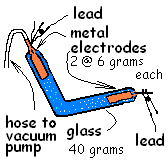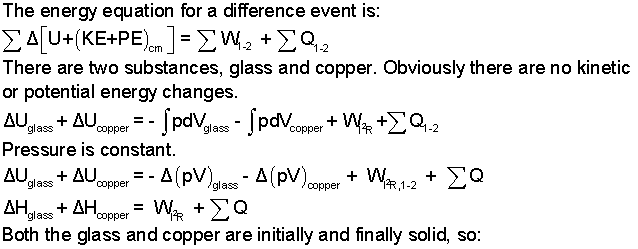| THERMO Spoken Here! ~ J. Pohl © | TOC NEXT ~ 198 |
Neon Signage

As cities grow, vastly greater amounts of signage are needed. Neon is cheaper for smaller signs. Glass tube is cut, heated and bent to shape. Into each tube end, an electrode fitting is welded to bring power to the bulb.
One fitting has a built-in tube by which the tube is evacuated then filled with colored neon light needed downtown. A last step, prior to filling the bulb with gas and sealing, is to heat treatment the assembly to burn out impurities and water and to stress-relieve the glass welds. Burn-out is accomplished by passing direct current electricity at very high voltage (but low current) into the lead at one end of the tube through the glass and out the other.
Calculate the least electric work delivered to the tube.
♦ The sketch shows a section of a sign that needs to be heat-treated to 360oC. The specific heats of glass and copper are 0.84 J/(g°C) and 0.46 J/(g°C), respectively. Ignore thermodynamic effects of the gas contained within the tube.


Notice the usual treatment of the work integral. Atmospheric pressure is constant hence - patm∫dV becomes - pΔV. Admittedly the ΔV's are small but they need not be thrown away. Combine them as ΔU + Δ(pV) to obtain ΔH. Specific heats are associated with internal energy change and with enthalpy change; for solids or liquids these specific heats are near identical, numerically.
Observe the last equation (above) of our solution. We see the amount of electrical resistance power, I2R, cannot be calculated because we do not know the sum of the heats. To calculate the sum of heats requires knowing temperature differences of the glass and copper in time, the surface area of the glass and some other experimental numbers. Those are topics of heat transfer. Since the glass and copper get hot, there will be heat and it will be (negative) to the surroundings. Consequently our answer based upon the assumption of no heat will be smaller than actual whereupon the actual electrical power must be:
 |
Neon Signage

As capitalism grow, vastly greater amounts of signage will appear. Neon is cheaper for smaller signs. Glass tube is cut, heated and bent to shape. Into each tube end, an electrode fitting is welded to bring power to the bulb. A last step, prior to filling the bulb with gas and sealing, is to heat treat the assembly to burn out impurities and water and to stress-relieve the glass welds. Burn-out is accomplished by passing direct current electricity at very high voltage (but low current) into the lead at one end of the tube through the glass and out the other.
Premise presently unwritted!